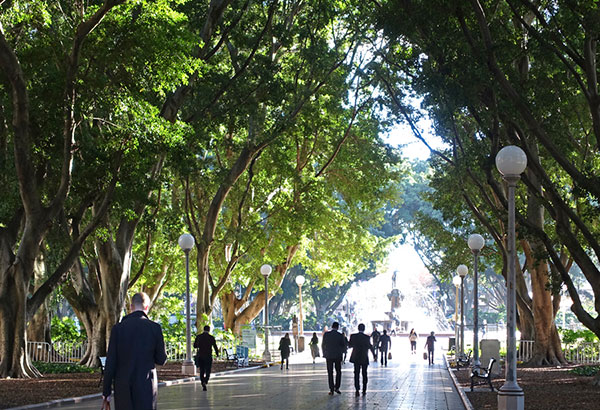Seeing green in Sydney


Hyde Park is embedded in and well connected to Sydney’s central business and commercial district, so it is vibrant with life.
Distinctive skylines and iconic buildings mark most great cities of the world. I believe that greatness lies not just in these architectural elements but, just as importantly, in the public spaces that these cities provide for their residents and visitors.
Sydney is synonymous with its elegant Opera House and the nearby Harbour Bridge. I found myself with my family in the Australian city recently and took a look at both — touring the Opera House inside and out, but limiting myself to views of the giant Art Deco bridge from ferries that ply the many quays and coves of this wonderful Australian metropolis.
What is even more wonderful in this city, and actually the main aim of my trip to this urban center Down Under, is to experience its parks, gardens, and public spaces. Our own Manila does have some green open space, but Sydney has a more extensive greenery and civic spaces, which are also better integrated with the daily lives of its citizens. They are better maintained, and more tourist-friendly than ours for sure.
The main bulk of Sydney’s green spaces are located behind the landmark Sydney Opera House. Architect Jorn Utzon’s masterpiece is actually younger than most of Sydney’s parks by a century. Since the 1800s Sydneysiders have benefitted from the amenities of The Royal Botanic Garden, The Domain, and Hyde Park. The three make up a swath of greenery, almost two kilometers deep and up to 600 meters wide, that runs parallel to the city’s main central business and commercial districts.
One of the first places that we visited was Hyde Park. We took a fascinating walking tour of the park and the sites and structures of The Domain, which contain or adjoin the city’s historic civic structures.
Hyde Park is a formal rectangular space of about 16 hectares (eight times larger than the Ayala Triangle Gardens). The park’s focal point is the large Archibald Fountain, with the magnificent St. Mary’s Cathedral in the background. The cathedral is Catholic and therefore a favorite of expat Pinoys and visiting Filipinos.
There is a chess park nearby like the one we have in Rizal Park, but this has a giant chess set. Our bunso and budding grandmaster Juancho returned to this spot four days in a row during our visit, and managed to play with the local aficionados.
My favorite element of Hyde Park is its Southern section, anchored by the 1930s ANZAC Memorial, an Art Deco masterpiece. A large reflecting pool provides a mirror image of the memorial, which is today set against a backdrop of taller, modern buildings.
Moving North from Hyde Park, we hit the Domain, a 34-hectare linear parkland that lines the Eastern edge of Sydney’s CBD from Hyde Park all the way to the Sydney Opera House. We walked the length of The Domain visiting the Art Gallery of New South Wales and into the Royal Botanic Gardens.
The Gardens cover 30 hectares and was established 201 years ago. It celebrated its bi-centennial last year and was spruced up for the event. We visited the gardens a few days into our trip and took an educational walking tour starting from its central Palm Grove Centre, which has a visitors’ center, bookshop and restaurant.
We walked the four sections of the site — the Lower Gardens, the Middle Gardens, the Palace Gardens and the Bennelong area — working our way north to the famous Mrs. Macquarie’s Point, which provides the best views of the Opera House.
We reached the spot at noon and noticed along the way hundreds of runners. Apparently, many local office workers like to run during their lunch breaks. Where do they shower after? We noted, too, that all the parks and the whole city are bike-friendly, with dedicated and segregated bike lanes in large sections of even the CBD.
At Mrs. Macquarie’s Point, we took the requisite selfies, but I also managed to sketch the Opera House, while the wife and kids were wandering about. I noted how well tourist movements and numbers were accommodated by the gardens. All three parks and gardens are visited by close to four million tourists a year, but locals also do use these amenities daily. It is a testament to the local authority’s excellent management and maintenance that the Royal Botanic Gardens, The Domain and Hyde Park are kept in great condition and constantly improved.
These three main green spaces of Sydney have a total area of about 80 hectares. This is 22 hectares larger than Rizal Park’s area. The population of Sydney is just over five million, while Metro Manila’s is over 12 million. Other than Rizal Park, Metro Manila has about 50 hectares of publicly accessible parkland in Quezon City. Therefore just over a hundred hectares of parks service Metro Manila residents.
In contrast, other than the three main parks in historic Sydney, this city has extensive waterside public space in its many coves, as well as over 30,000 amazing hectares of parks in its suburbs and fringes.
Sydney continues to upgrade its public parks and civic spaces. The city is, in fact, building more parks. The newest one is Barangaroo Headland Park west of the Rocks. I’ll write about this, the Opera House and Sydney’s famed waterside esplanades next week.
In the meanwhile, back in Manila, I wonder how we will correct the imbalance of population to parks and open green space.
* * *
Feedback is welcome. Please email the writer at paulo.alcazaren@gmail.com.



















